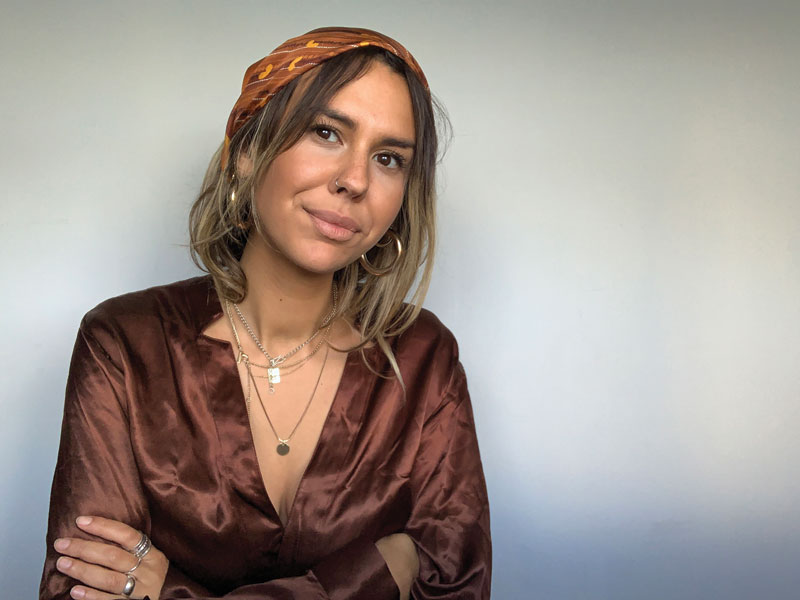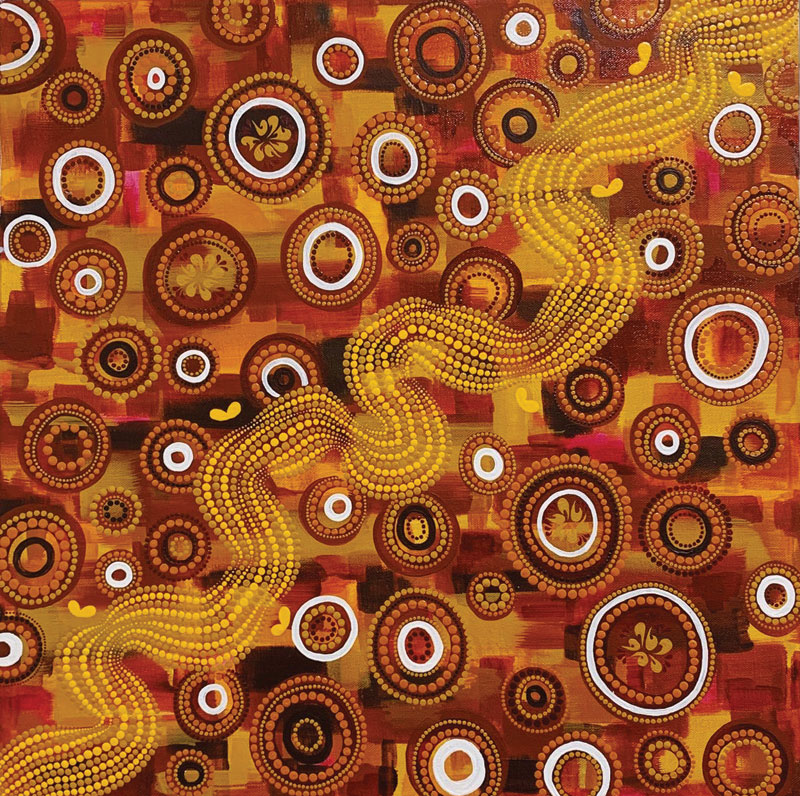
As Bristol celebrates the launch of the UK’s first Aboriginal-owned gallery this month, we speak to founder Jasmine Coe all about the highly anticipated Coe Gallery…
This month, Bristol will welcome the UK’s first Australian Aboriginal-owned gallery dedicated to supporting emerging Australian Indigenous artists. Gallery founder and curator Jasmine Coe – a Wiradjuri-British artist and the daughter of Aboriginal justice and land rights activist Paul Coe – will be launching Coe Gallery with a group pop-up exhibition at The Vestibles on 12 July.
Supported by Bridging Histories and the University of Bristol, the exhibition entitled Our Stories, Our Journey will comprise of works from nine emerging artists exploring themes of continuation and identity through connections with land and culture.
Having struggled with race and self-identity growing up, Jasmine’s work focuses on harmonizing internal conflicts that arise from having two lines of heritage, which together hold a traumatic history. In an attempt to heal self, painting became a restorative process whereby the understanding of self-identity was given space to develop, while at the same time the work continues to celebrate the beauty of the natural world. Ahead of the exhibition this month, we caught up with Jasmine to find out more…
How does it feel to be launching Coe Gallery in July? When did you first have the idea for the gallery?
It’s so exciting to be putting on a pop-up exhibition for Coe Gallery. The event will be at the Vestibules for three weeks from 12 – 28 July, celebrating emerging Aboriginal art and artists. At Coe Gallery, we felt it important for Aboriginal people to have a space in the UK that contributes towards Aboriginal artists regaining control of the narrative and how their stories are told. As far as I am aware, all galleries that exhibit Aboriginal art here in the UK are non-Aboriginal owned. As important as these galleries are in providing visibility and supporting artists, having a space that is artist-led is a step towards providing fairer representation and is self-determination in action, allowing for meaningful cultural exchange with the hope for healing opportunities. Bristol is a diverse city and I have found the people here to be embracing of many different cultures. The art world can, at times, feel elitist. It would be great to have a space that breaks down these barriers and feels inclusive and welcoming to all cultures and people.
Why did you choose to launch Coe Gallery in Bristol?
Bristol is a progressive city in terms of its activism and ability to raise important conversations surrounding change. I believe that in these times of change where colonial narratives are being questioned, there is space here for the Indigenous experience to be heard. In my experience, Bristol is a place that celebrates cultures, inclusion and diversity.

Bristol also has its own connections with Australia, being home to the SS Great Britain. During the 1800s this ship alone was responsible for carrying more than 15,000 people from Liverpool to Melbourne and according to sources, the descendants from this ship alone now average around 500,000. Today, because of the on-going effects of colonialism, the total Aboriginal population averages at around 800,000, which when compared to the general Australian population (25.6 million), these two figures are dramatically close in comparison. Colonialism has continuous effects on the Indigenous community in Australia. I feel it important to have a space in Bristol that is dedicated to Aboriginal art and Aboriginal artists which focusses on a sense of belonging, visibility, identity and respect.
Can you tell us about when you started to explore your heritage through your work, how it became a restorative process and how your style has changed over the years?
When I came back from Australia, I found that painting was a place where I could process some of the things I had learnt. It allowed a space to develop self-identity and enabled a continuous connection to the values I now use in my work which celebrate the natural world.
Can you tell us more about your Wiradjuri heritage and what you have learned about it over the years?
Wiradjuri country is the biggest language group in New South Wales. Wiradjuri people are also known as ‘people of the three rivers’. The Kalare, also known as the Lachlan, is one of three main Rivers that run through Wiradjuri country along with the Murrumbidgee and the Macquarie. The Kalare runs through the town where my family are from. Being able to spend time on the river and where my father grew up allowed me to connect to my heritage and understand how important it is to maintain this connection to our natural world. Due to climate change and irrigation systems that are used for cotton farm production, the rivers face over extraction. The stagnant water that is left behind soars to high temperatures. In 2019, over a million fish died because the water became deoxygenated. What I have learnt from connecting to my Wiradjuri heritage is to ‘care for country’. There is a balance of life that has existed for over 60,000 years where everything has its purpose. It is in keeping with the land.
What do you hope Coe Gallery does for emerging Aboriginal artists in the UK?
I hope Coe Gallery will provide emerging Aboriginal Artists with a safe space to exhibit their work and share their stories; how they feel comfortable. I hope one day we can offer artists the chance to come over here and participate in meaningful cultural exchange.
See more of Jasmine’s work at: jasminecoe.com. Find out more about the exhibition at: artspace.uk/venue/vestibules
https://thebristolmag.co.uk/art-of-connection-a-qa-with-founder-of-the-new-coe-gallery-jasmine-coe/

